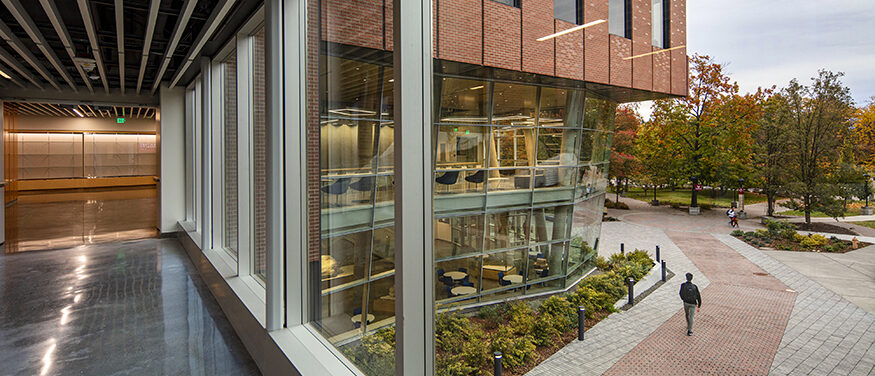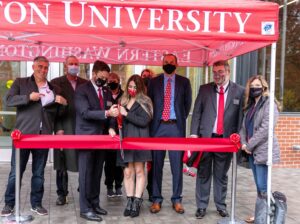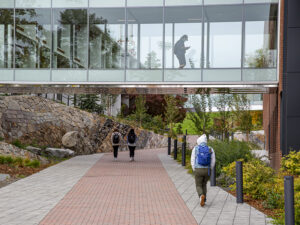STEM Central

A gleaming new Interdisciplinary Science center Promises a new era for ‘teaching, learning and discovery’ at EWU.
By Charles E. Reineke
On a rainy fall Friday in October, the kind of weather only a meteorologist could love, a small crowd gathered to witness David May, EWU interim president, join pre-med student Tayrn Wilson in cutting the ribbon on a new era for Eastern science and scholarship.
The pandemic-delayed opening of Eastern’s Interdisciplinary Science Center (ISC), a $67 million, 102,000 square-foot marvel, promises to be a seminal event for a university that has long recognized its need to boost research and development. And while Eastern’s foundational commitment to excellence in the humanities will not change, the capabilities unleased by the new ISC, along with the upcoming top-to-bottom remodeling of its companion Science Building, represent a transformational moment for the 139-year-old institution.

Championed by the late Mary Cullinan, EWU’s previous president, the ISC represents a key part of the university’s push for a greater emphasis on science, technology, engineering and mathematics, otherwise known as STEM. The idea, officials say, is to provide an edge for university researchers and students as they navigate these economically vital, and increasingly competitive STEM-related disciplines. And what’s good for the nation’s economy promises to be good for graduates’ employment prospects: The U.S. Bureau of Labor Statistics, for example, recently projected that (the typically high-paying) jobs in the STEM fields will grow 8 percent by 2029, compared to 3.7 percent for all occupations.
“We have been eagerly awaiting this day, the opening of this building is special,” said May at the event. “Just one month ago our students were finally able to set foot inside what has remained mostly vacant for just over a year. They finally have the opportunity to learn in this dynamic, hands-on environment of teaching, learning and discovery.”
State lawmakers Sen. Jeff Holy, R-Cheney, and Rep. Marcus Riccelli, D-Spokane, each of whom were instrumental in helping EWU secure state funding for the project, also spoke briefly to the crowd.

Holy, ranking member of the state senate’s Higher Education & Workforce Development Committee, touted EWU as a “best value” in higher education, saying that Eastern has produced the highest percentage of STEM graduates of any other state college over the past 8 to 10 years. Eastern, he said, is a proven leader in higher education.
As he gestured toward a gleaming wall of glass behind him, Riccelli offered that the ISC further distinguishes Eastern Washington as a force to be reckoned with among the state’s institutions of higher learning — even those powerhouses to EWU’s west and south. “We’re not the other Washington anymore,” Riccelli said to enthusiastic applause.
Dignitaries aside, perhaps no one deserves more credit for the ISC than David Bowman, a professor of geology and dean of EWU’s College of Science, Technology, Engineering and Mathematics.
Bowman is an energetic Southern Californian whose disarming laugh and passion for learning make him an ideal ambassador for all things science. He arrived at Eastern from Cal State Fullerton, where the seismology specialist served for 12 years, including six as chair of the university’s geological sciences department. Before that — with a freshly minted doctorate from the University of Southern California in hand — Bowman completed a postdoctoral stint in tectonics at the Institut de Physique du Globe in Paris, where he was a Chateaubriand Postdoctoral Fellow.
Earthquake researchers are typically well-traveled. Bowman is no exception, having led studies in remote, often challenging locales across the globe. After landing in Cheney five years ago, he put aside the fieldwork and immediately set about making the ISC a reality. Getting to the ribbon-cutting was as demanding as any of those previous projects.
The process involved three stages, Bowman says. The first, “predesign,” predated his arrival. “This is where you work with the architects to figure out what the need is, identify a location, and make a thumb-nail sketch of what you want to do,” Bowman says. “That took about two years.”
Next came the actual designing of the building, another two-year process that Bowman joined a year-and-a-half in. Coming up with the final design, he recalls with a chuckle, “involved a lot of detail and assessment of needs — assessments that typically involve endless meetings with faculty and facilities planners.”
Lastly was making construction of the building happen. “My job,” he says, “was to go to the legislature and make sure we actually got the money to build. A lot of my first year at Eastern was spent in Olympia.” Luckily, most members of the legislature were eager to sign off on Eastern’s well-designed plan for giving STEM a boost. “For the most part, no, it wasn’t a hard sell,” Bowman says.
Now that the building is open and in-person learning has resumed, EWU students are already reaping the benefits of the center’s four floors of laboratories, study areas and workspaces.
The ground floor entryway, with its display cases featuring exhibits from Eastern’s large collection of relics from studies past, features light-filled, personal-technology-friendly spaces for student study and collaboration, just one of many such spaces throughout the building.
Floor zero, as Bowman calls it — “it’s a European thing,” he says — is also home to two geology labs and a “smart” lecture hall which is large enough to accommodate public appearances by high-profile guest speakers.

The second story, floor one, is outfitted for upper-division chemistry and biology instruction, with rows of well-equipped classroom laboratories. Despite years of retrofitting, labs in the old Science Building have had to rely on outdated technology for crucial systems such as fume hoods, exhaust venting and air-change systems. The ISC, on the other hand, is state-of-the-art.
“This building has a modern, high-energy, high-efficiency air handling systems. It’s also really energy efficient for a science building, which helps us to advance our green-certification credentials,” says Bowman.
Another feature of the spaces, on floor one and throughout the building, are sight lines both out to the corridors and from lab-to-lab. These “windows on the work” represent the type of unexpected ISC design element that is both arresting visually and potentially game-changing for student learning. They may also help with recruitment.
“All of the labs have these glass walls, so that you can see what’s going on,” Bowman says. “The old Science Building, as you know, looks kind of like an ICU or a morgue — or both. It’s dark, it’s dreary, it’s scary. The ISC rooms are meant to be light and airy. I just can’t wait to have prospective students going on a tour through here. They will be able to see a class going on; actually see the exciting classroom experience that they could be a part of.”
The next floor up is reserved for geology and physics, including a new home for Eastern’s extensive collection of fossils. Bowman holds up a particularly well-preserved plant impression and explains how a new generation of researchers are making use of these “postcards” from our distant past. Because they helped locate potential oil reserves, he explains, investigations of fossilized plants used to be the provenance of Big Oil. “Now,” Bowman says, “they’re really important to us as we seek to better understand climate change. We can only know what might happen in the future if we know what happened in the past.”
There certainly is nothing “past” about the building’s exterior, a gleaming mash-up of brick, steel and glass set at jutting angles that seem to propel the structure forward. Designed by Seattle-based LMN Architects and constructed by Spokane Valley-based Lydig Construction, Inc., the ISC makes a powerful statement about the nature of the activities taking place inside. Perhaps not unintentionally, it also gives a visual shout-out to Bowman’s particular area of expertise, geosciences.
When viewed the right way, he says, the building resembles a geode, complete with angular crystals and glistening surfaces. Gesturing toward the colorful rock facings of the complex’s retaining walls, Bowman adds that these, too, have useful analogs to the natural world. “You can see that the walls have different shapes cut into them? These are meant to simulate geological cross-sections, so that we can go out with students and show them what, say, a fault looks like in the geological cross-section of the Earth.”
Even the plantings provide a landscape for learning. “They are all actually part of the intentional design — each of the different landscaping areas represents unique biozones in the state of Washington,” says Bowman. “Our goal was that even the plant material would become part of the teaching.”
Fusing instruction and research is, in fact, central to the ISC mission. Since its founding as a Normal School for teaching teachers, undergraduate instruction has been at the core of Eastern’s identity. And while that proud tradition won’t change, the new ISC represents a bridge to new forms of learning, methods that bridge research and instruction to give students hands-on experiences in rapidly evolving STEM fields.
Given this change, it’s fitting that a more literal bridge comprises one of the ISC’s most striking features — two, glass-enclosed walkways linking it to the original Science Building, which recently got the legislative nod for a $45 million makeover. When fully renovated, the Science Building will join the ISC as part of a “science-innovation complex” aimed at advancing faculty research and giving students a leg-up on future academic and professional careers. As home to advanced labs and research workspaces, the renovated building will usher in a new era of scientific investigations at EWU, work that will not only expand Eastern’s role as a regional center for innovation and discovery, but will expand student opportunities.

“The ISC really starts with the Science Building,” Bowman says. “The Science Building is old. It’s a Sputnik-era building for Sputnik-era science.”
Over the decades, Bowman continues, the university has struggled to adapt spaces in the building to the needs of research faculty. “It’s just not designed for modern stuff; it’s really, really challenging to do contemporary science in that building. It wasn’t even a lab building to begin with! I mean, there used to be a theater in there!”
“It’s been bubble gum and Band-aids,” he adds. “And that has been a major constraint on faculty and student research. For the College of STEM, engaging students in faculty research is key. Our faculty have to do research for their tenure, obviously, just like anywhere. But one of the things that distinguishes us is that we have undergraduates working with faculty on those projects.”
When the reimagined Science Building opens its doors four years from now, beginning science students will take core classes in the ISC, while advanced undergraduates will round out their degrees with the participatory research experiences that Bowman deems so crucial. Together, he says, the linked buildings will allow STEM students near boundless opportunities to future-proof their careers.
At the rainy ISC ribbon-cutting, Bowman used his turn at the microphone to remind the crowd that the moment was about more than brick and mortar, circling back to that commitment to education that has defined Eastern since its days as the Benjamin P. Cheney Academy.
“A new building is a wonderful thing, but it’s the activities in the building, and the people it touches, that really matter,” Bowman said.
“From the geology labs on the ground floor, to the STEM Student Senate Chambers on the third floor, this building is for students — a place where future scientists, business people and community leaders can build a fabric together while learning about the sciences and technologies that have, and will continue, to shape our world.”
Filed Under: Campus Featured Research Science
Tagged With: Fall/Winter 2021


